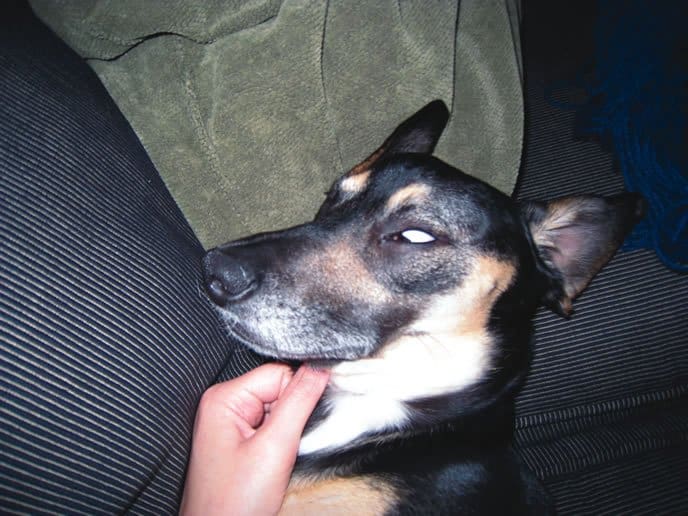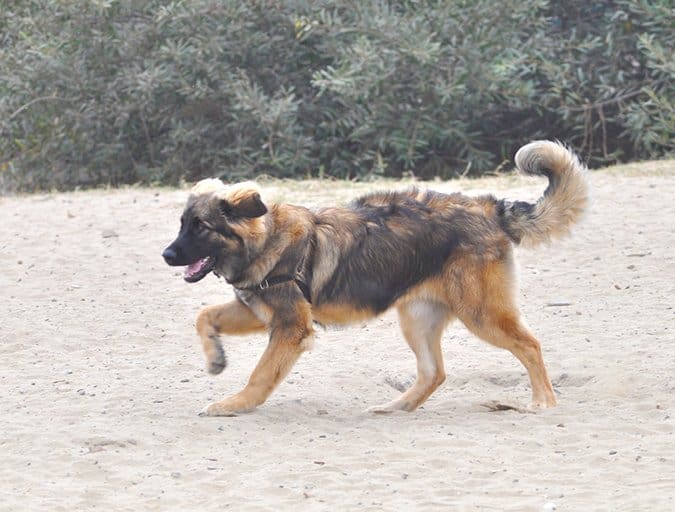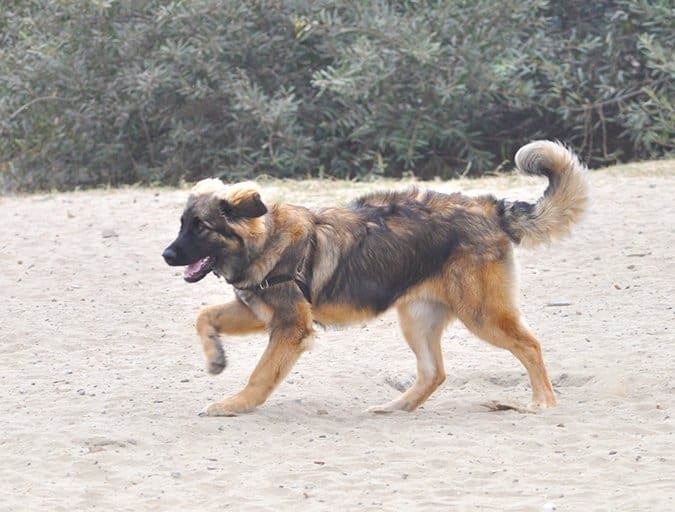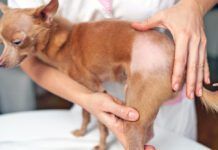
Megan Brophy-McClean
If you live with and love dogs, chances are at some point you’ve found yourself at a familiar – and often excruciating – tipping point. “I just noticed (fill-in-the-blank),” you say to yourself. “Should I panic? and race to the dog emergency vet clinic?
The standard response that everyone gives – and for good reason – is this: When in doubt, see your vet. And of course, you should, if you suspect something is truly amiss. But you can’t go running to the dog emergency vet clinic every time you notice something weird, especially if it’s more an issue of benign bemusement rather than an out-and-out emergency. Problem is, you don’t know what you don’t know: Something that may seem really strange could be absolutely nothing, and a seemingly subtle symptom could be a harbinger of something truly disastrous. If only dogs came with an owners’ manual – or a customer-care line!
Actually, some sort of do, if you acquire your dog from a reputable breeder or rescue group. Folks who have been “in dogs” for a good length of time often amass a tremendous storehouse of practically gained knowledge, and that can come in very handy. And often, “dog people” are willing to share advice with novices, if only to help them sift out the trivialities from the true alarm bells.
I’ve been on the receiving end of those kinds of phone calls for a number of years, and on occasion I still make them, too. Here are some of the “emergencies” I’ve encountered over the years that turned out, happily, to be nothing to worry about. Again, reading about my personal experiences is no substitute for veterinary care, but at the very least you can add it to your storehouse of knowledge. Somewhere down the road, you might just need it.
When Your Dog’s Eyes Seem to Have Gone White
Most people don’t know the technical name for the dog’s third eyelid (that would be “nictitating membrane,” in case you’re taking notes), much less what it is. But whatever you want to call it, it can be unsettling when you glimpse this milky membrane glide across your dog’s eye – usually while she is sleeping, her muscles twitching as she partakes in some somnambulant rabbit-chase. The resulting all-white eyeball can look like a close approximation of demonic possession. No matter what it seems like to you, it’s usually perfectly normal.
The third eyelid, sometimes colloquially called the “haw,” is a translucent membrane that usually is not visible in dogs. Sometimes an eye injury, such as a scratched cornea, will cause the third eyelid to cover and protect the eye; some ophthalmological conditions, such cherry eye, can also cause the haw to be visible and prominent. In those situations, a veterinary consult is needed and necessary (though not a middle-of-the-night emergency).
More typically, owners notice the third eyelid when their dog is dreaming, in that middle ground between sound asleep and awake, when her eyes are darting around in dream mode and her eyelids are partially open. It looks a little freaky, but once she stops her slumber, the membrane will slip back where it belongs – out of sight. Here’s a video where one dog owner helpfully caught the third eyelid in action while his dog slept: tinyurl.com/thirdeyelid
Higher BUN in Raw Fed Dogs
If you’ve opted to feed your dog a raw-food diet, it’s important to remember that a lot of the so-called “norms” for dogs are based on data on kibble-fed dogs. As a result, your mileage can and often will vary.
For example, a 2003 study done by veterinarians W. Jean Dodds and Susan Wynn found that dogs fed raw meat had higher red blood cell and blood urea nitrogen (BUN) levels than dogs fed cereal-based food. If you have a routine blood panel run at a wellness exam, or if your vet has your dog’s blood tested as a diagnostic tool, a raw-fed dog’s high BUN levels will usually set off the alarm bells, because they can signal compromised kidney function.
Don’t assume that your vet knows that higher BUN levels are normal in raw-fed dogs. Several years ago, a friend who bought one of my raw-fed puppies took the dog to be spayed; when Dakota’s pre-surgical bloodwork showed an elevated BUN level, a newbie veterinarian at the practice admitted Dakota and put her on fluids. The worried owner called me, and I in turn called the vet, who then pulled the plug on the unnecessary treatment.
When Your Dog Isn’t Drinking Water
Another area of undue concern with raw-fed dogs is water consumption. If you are accustomed to living with kibble-fed dogs, a raw-feeder will appear to be a camel by comparison. That’s because unlike kibble, which has its moisture content extracted in order to increase its shelf life, raw meat is very well hydrated; raw-fed dogs aren’t constantly slurping up water because it hasn’t been removed from their food to begin with. I can’t tell you how many puppy people have called me over the years, seriously concerned because their new puppy has only taken a cursory sip of water. If the puppy is behaving and playing normally, I tell them, don’t worry.
Of course, there are diseases that can cause a dog to reduce her water intake, and any significant change in water consumption should be cause for concern. Fresh water should always be available to your dog.
Abnormal Canine Genitalia?
I promise I am not making this up: I had one puppy person, a very nice lady, email me in a panic about the severe flea bites on her puppy’s belly. A picture is worth a thousand words, and once I reviewed the one she sent me, I responded and told her she could relax: Those weren’t flea bites. They were nipples.
You can laugh, but the reality is that with the prevalence of spaying and neutering, for good or bad we have lost touch with our sense of animals as sexual beings. Since the dogs don’t use those “parts,” many owners have no idea what is normal or not normal regarding them.
News flash: Male dogs have nipples, just like male humans do, though they not immediately visible, even on short-haired dogs. Unlike male humans, who have only two, boy dogs have multiple pairs. And theirs don’t work, either.
Speaking of male dogs, you should know that neutering usually but doesn’t always eliminate their ability to achieve what we’ll delicately call a state of readiness. Owners who are distraught to see what they think is a penile infection might in fact be seeing the prelude to an erection: If you see a protruding something that resembles a pink lipstick cylinder, that’s basically your signal that Buster is very, er, happy. (Or, sometimes, stressed. It depends on the context!)
Wait, there’s more. Everybody knows that male dogs are neutered in order to prevent them from procreating, but a surprising number of people don’t know that this process involves removing the testicles. After bringing their dog home after the procedure, some owners grow concerned that those dangly bits were never removed, since it appears that they’ve reappeared. The reality: Post-surgical blood pooling in the scrotum, which is not removed, can make it seem as if the dog still has testicles. Keep an eye out for infection or a break in the wound, and, of course, call your vet if you are concerned.
As to those dogs who were neutered long ago but who seem to have testicles sometimes, but not others? When a male dog (neutered or not) has an erection, his owner might notice a pair of hard, egg-shaped lumps under the skin toward the base of his penis. This is actually part of the anatomy of his penis called the “bulbus glandis.” Most of the time, these “lumps” can’t be seen, but when the penis becomes engorged during arousal (sexual or any sort of physiological arousal, including play and stress), the bulbus glandis also becomes swollen and hard, appearing as if somehow the dog regenerated some very firm testicles! Their appearance is normal, temporary, and nothing to worry about.
Lameness in Young Dogs
Orthopedic problems are always a worry in young dogs, especially in larger breeds that can be prone to hip dysplasia. I’ve had more than one dog inexplicably come up lame between the ages of six to 12 months, visibly limping on one leg or unable to put weight on it. Often the limp “travels” from one limb to another, and always gets worse with exercise. It looks pretty dramatic, and it’s easy to assume that it’s something very serious.

In all those cases, though, what I was dealing with was paneosteitis – a fancy word for “growing pains.” No one knows what causes it, though there are plenty of theories, from high-protein dog food to viral infection to genetics. What everyone agrees on is that while “pano” is painful, eventually the dog outgrows the condition, and returns to normal.
Paneosteitis is common in a number of breeds, including Rottweilers, Great Danes, German Shepherds, and my breed, Rhodesian Ridgebacks. When a puppy owner reports that telltale “traveling” limp between six and 12 months of age, I usually suggest administering a baby aspirin (never, ever ibuprofen products like Advil, which is toxic to dogs). If it is pano, the aspirin will usually relieve the pain within an hour or so (though it will likely return once the drug wears off).
Since there is no treatment for pano other than tincture of time, this lets the owner know to keep the dog from being too active (good luck with an adolescent!) and to see her vet and ask for some pain-relief medication if the discomfort appears too great.
It’s helpful if you know your dog’s history, and whether pano “runs” in his family. Again, don’t assume that your vet will suspect pano, even if your dog is the “right” age and breed for it. (Google “pano” and “Basset Hound,” and you’ll find plenty of links where veterinarians suspected – and in some cases, tested and even treated for – everything from elbow dysplasia to cancer.) Radiographs will reveal changes in the bone marrow that are indicative of paneosteitis.
If Your Dog Vomits Bile
The first time your dog or puppy vomits up a viscous pile of bright-yellow bile, it’s understandably a bit of a shocker. And vomiting shouldn’t ever be dismissed out of hand, as it can be a sign of a serious problem. But if your dog is acting otherwise perky and normal, what you’re likely seeing is a dog relieving himself of a build up of bile in his empty stomach. When “grazing” outside, dogs sometimes nibble grass, which also promotes bilous vomiting if the dog hasn’t had his meal yet.
Since the vomiting is caused by an empty stomach, you can often eliminate it with a simple diet change: Change your dog’s feeding schedule, or offer two meals instead of one during the day.
Look at Your Dog’s Poop
It sounds gross, but making sure your dog’s stools are consistent and normal is an important part of monitoring his health.
Quinoa has become popular with owners who feed a home-prepared diet. It appears on my “Don’t panic!” list, due to the curled appearance of the cooked germ, which can sometimes pass through a dog intact and easily be mistaken for roundworms in the stool. At least I find out who is really paying attention to their dogs’ stool, though!
Denise Flaim, of Revodana Ridgebacks, lives in Long Island, New York.







I have a puppy and noticed when he urinates a little liquid is left on the tip of his penis and it’s milky lite blue in color is this normal
it may not be. if your puppy is at least 6 months old he could produce semen. but if it is light blue than it should be something to worry about. I am no expert just my opinion
Can male chihuahuas get boils by their penis like humans do ..my 9 yr old male has this huge lump that wasnt there a few days ago ,and its feels squishy like a water balloon that’s about to burst..
He has had a recent mouth infection that im worried he spread when he was cleaning himself ..dont know if I should just let it heal on it’s own or take to vet.. I know hes old and is going blind and most likely has diabetes cause his pee is very oily but I’m scared they will want me to put him down even though he is happy and active like a puppy ..pls help with advice I cant lose him .I have had him since he was 6 weeks old and hes now 9 almost ten …..pls tell me what to do
Yes I have a 4 month.old pit lab mix and his got real sick throwing up and dirarrea wouldn’t eat or drink for. 6 days finally got him through that with me pushun fluids tlthrough him and now he has these bumps all over. His belly and around. His penis should I. Be alarmed
FWIW, most of what is showing on the video of the sleeping dog is the sclera, not the eyelid; if you look closely you can see the dog’s eye is rolling around as she dreams, mostly looking down/toward the muzzle
my dog got hit by a car and its testicle is hanging out. do i need to get to a vet asap
I hope this is a joke but incase it is not…
Re-read your comment as of someone was asking you. If you really can’t figure the correct answer out then you should not have pets.
Yes, you should have taken him to the vet immediately.
Any chance anyone knows what the mix of the dog is in the first picture? My dog Rocky looks almost identical.